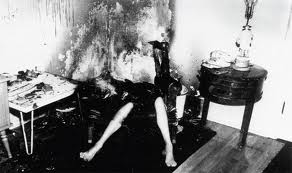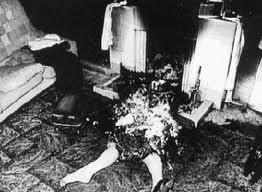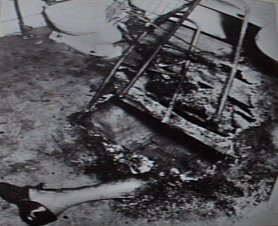It looks like you're using an Ad Blocker.
Please white-list or disable AboveTopSecret.com in your ad-blocking tool.
Thank you.
Some features of ATS will be disabled while you continue to use an ad-blocker.
4
share:
Two cases of spontaneous combustion in the news right now. There have only been 200 cited cases over the last 300 years and yet we have two cases in
the news in the same day.
Oklahoma man found burned, spontaneous combustion not ruled out
Girl catches fire at Oregon hospital
I suggest these are cases of hydrogen sulfide getting into their clothes. Here is the website with information about a theory that hydrogen sulfide plumes are releasing all over the place and wreaking havoc such as this.
Jumping Jack Flash Hypothesis
Here is a quote from the Jumping Jack Flash website about the case of the Oklahoma man.
How rare is spontaneous human combustion?
From Wikipedia
And more from Wikipedia
Any thoughts on this ATS. Am I wrong about this or is this just simple cases of a rare phenomenon?
Oklahoma man found burned, spontaneous combustion not ruled out
Sheriff Lockhart spent about 20 years as an arson investigator for the Fort Smith, Arkansas Police Department, before retiring to run for Sheriff in Sequoyah County. Lockhart said he'd never seen anything like it. He said it didn't seem that any accelerant was used and only the floor below Vanzandt's body was damaged.
Girl catches fire at Oregon hospital
The girl, Ireland Lane, had been painting in her room at Doernbecher Children's Hospital, ABC affiliate KATU reported. Moments later, she ran into the hallway screaming, with her T-shirt aflame. "I've been in medicine going back 30 years now and never heard anything like this. And hopefully I never will again," Dr. Stacy Nicholson, physician-in-chief at Doernbecher Children's Hospital, told KATU.
I suggest these are cases of hydrogen sulfide getting into their clothes. Here is the website with information about a theory that hydrogen sulfide plumes are releasing all over the place and wreaking havoc such as this.
Jumping Jack Flash Hypothesis
Here is a quote from the Jumping Jack Flash website about the case of the Oklahoma man.
They say it was possibly spontaneous combustion. Obviously it was. But it was the man's clothes that spontaneously combusted, and possibly his hair. Those are absorbent flammable materials and all such materials are absorbing hydrogen sulfide and/or methane and spontaneously combusting. There have been numerous incidents like this now, of people - or rather their clothes and maybe their hair - simply bursting into flame, and there are going to be increasing numbers of people burning to death this way as the number, size and concentration of gas plumes in the atmosphere continue to increase...
How rare is spontaneous human combustion?
From Wikipedia
Spontaneous human combustion (SHC) describes reported cases of the burning of a living (or very recently deceased) human body without an apparent external source of ignition. There have been about 200 cited cases[1] worldwide over a period of around 300 years. There are many hypotheses that attempt to explain human spontaneous combustion: Natural explanations based on unknown or otherwise unobserved phenomena (e.g. that the production of abnormally concentrated gas or raised levels of blood alcohol might cause spontaneous ignition) Natural explanations relating to health and lifestyle factors (e.g. smoking, not consuming adequate levels of water etc.) Natural explanations that involve an external source of ignition (e.g. the victim was drunk and dropped a cigarette)
And more from Wikipedia
The spontaneous combustion of people (i.e. death from a fire originating within the victim’s body without a direct external cause) is a theoretical explanation for a number of unexplained cases, some of which are well-documented but many of which are not. The more intriguing cases share the following characteristics: The body is completely or almost completely incinerated, while nearby furniture exposed to high temperatures remains intact. Damage is limited to the victim’s body and clothing, to the area of the floor or furniture on which he or she died and to the ceiling above the corpse. The torso is the focus of the fire and if remains are found these are of the extremities, such as the feet. There are no traces of fire accelerant and the fire does not have an evident external cause. Often the combustion seems to happen simultaneously at many parts of the body, usually without any obvious points of origin. The victim is typically alone at the time of death and is thought to have been alive when the fire started, despite showing little sign of having struggled.
Any thoughts on this ATS. Am I wrong about this or is this just simple cases of a rare phenomenon?
reply to post by Rezlooper
The girl had just finished using a hand sanitiser that was believed to have been the cause. Although it is believed that her t-shirt was on fire, I can certainly attest to children using them to wipe their hands in almost every instance.
That being said, and although I feel these 2 incidences are mere coincidence, I am a firm believer in the phenomenon of SHC.



The girl had just finished using a hand sanitiser that was believed to have been the cause. Although it is believed that her t-shirt was on fire, I can certainly attest to children using them to wipe their hands in almost every instance.
news.ninemsn.com.au...
Cancer survivor Ireland Lane, who was being treated at Doernbecher Children's Hospital in Portland, Oregon for an unrelated head injury, reportedly ran screaming into a hallway with her T-shirt on fire earlier this month.
The fire started after the child used a hand sanitiser to clean a table where she had earlier been painting a wooden box as a gift for her nurses, the Oregonian reported.
Fire authorities are now investigating whether the blaze started when the hand sanitiser mixed with static electricity.
en.wikipedia.org...
Alcohol gel can catch fire, producing a translucent blue flame. This is due to the flammable alcohol in the gel. Some hand sanitizer gels may not produce this effect due to a high concentration of water or moisturizing agents.
There have been some rare instances where alcohol has been implicated in starting fires in the operating room, including a case where alcohol used as an antiseptic pooled under the surgical drapes in an operating room and caused a fire when a cautery instrument was used. Alcohol gel was not implicated. To minimize the risk of fire, alcohol rub users are instructed to rub their hands until dry, which indicates that the flammable alcohol has evaporated
That being said, and although I feel these 2 incidences are mere coincidence, I am a firm believer in the phenomenon of SHC.



edit on 20-2-2013 by Sublimecraft because:
The first time I heard about this was on an x files television series, it got my atention and I still rembember that tv show.
I think is this one:
47 23 "Soft Light" James Contner Vince Gilligan May 5, 1995 2X23 12.9
An ex-student of Scully's (Kate Twa) asks the agents to help her with her first investigation concerning a number of disappearances with very few clues. Mulder ponders the idea of spontaneous human combustion but rethinks it when they find a man (Tony Shalhoub) who is afraid of his own shadow. The man is Dr. Banton, a scientist researching dark matter. Guest starring Tony Shalhoub, Kevin McNulty and Steven Williams as X.
I think is this one:
47 23 "Soft Light" James Contner Vince Gilligan May 5, 1995 2X23 12.9
An ex-student of Scully's (Kate Twa) asks the agents to help her with her first investigation concerning a number of disappearances with very few clues. Mulder ponders the idea of spontaneous human combustion but rethinks it when they find a man (Tony Shalhoub) who is afraid of his own shadow. The man is Dr. Banton, a scientist researching dark matter. Guest starring Tony Shalhoub, Kevin McNulty and Steven Williams as X.
new topics
-
Tesla Cybertruck Explodes in Front of Trump Hotel in Las Vegas
Mainstream News: 4 hours ago -
Maybe they didn't get away with it: The Lincoln-Kennedy assassination parallels. 7 sentences long.
History: 6 hours ago -
Ukraine halts transit of Russian gas to Europe after a prewar deal expired
Political Conspiracies: 10 hours ago
4
